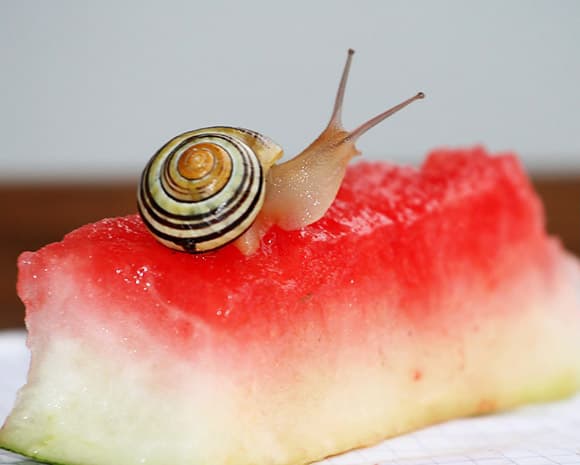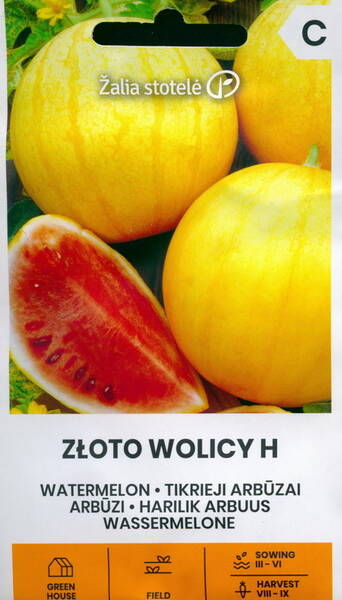Early hybrid. Skin of ripen fruit is yellow. Pulp is red, juicy, very sweet. Grown up fruit weights up to 6 kg.
Sown in nurseries in late April, and seedlings are planted to the permanent location in late May - early June.
Grown outdoors, and under cover. The hybrid is resistant to powdery mildew and cucurbit downy mildew.
1,0 g = 10-20 seeds.
* GROWING SEEDLINGS.
In Estonia, watermelon and melon can only be grown through seedlings, and the future harvest largely depends on their quality.
As with all pumpkins, the period for growing watermelon and melon seedlings is short - 30-35 days.
Seedlings are grown only in peat pots so as not to damage the root system during planting. Use pots with a diameter of 10 cm, in which 2 plants can be grown.
Before sowing, the seeds can be soaked or sprouted, which will shorten the period of emergence of seedlings.
To obtain good friendly shoots, it is necessary to ensure a fairly high temperature, at the level of +27+30°C. The temperature regime for growing seedlings is +20+25°C during the day (depending on the weather, on cloudy days the temperature is slightly reduced to prevent the plants from stretching), +18+20°C at night.
Since the seeds for seedlings are sown quite late (around mid-April), there is no need to provide additional lighting for the plants. However, the seedlings should be given the sunniest place in the apartment (southern windows are best).
The quality of the seedlings will be higher if they grow on a glazed and insulated balcony or loggia (in this case, it is necessary to ensure that the temperature is optimal). During the period of growing seedlings, 2 additional feedings with complex mineral fertilizers are carried out.
The arrangement of plants is of great importance: it is desirable that they do not touch with their leaves, so the pots must be periodically moved apart.
Seedlings ready for planting should have 3-5 true leaves. About a week before planting, the seedlings are hardened. The daytime temperature is reduced to +15+17°C, the night temperature is reduced to +12+15°C, and the ventilation of the plants is also increased.
There is one difference in growing watermelon and melon seedlings. The fact is that watermelon plants form female flowers, from which fruits subsequently develop, both on the main stem and on the side shoots. But on melon plants, female flowers on the side shoots are formed earlier than on the main one. It is this feature that determines such an operation as pinching the top of the melon plants above the 3-5 leaf. As a rule, it is carried out during the seedling period.
GROWING CONDITIONS.
In Estonia, watermelon and melon can only be grown in a greenhouse or under a temporary film shelter.
Greenhouse.
Can be of any shape and area, the main thing is that its height is at least 170-200 cm (watermelon and melon in a greenhouse are grown with tying the plants to a trellis).
As a rule, solar-heated greenhouses are used. Of course, most vegetable growers will not occupy their entire greenhouse with watermelon and melon; they usually grow peppers, eggplants, tomatoes, and cucumbers there. In this case, watermelon and melon seedlings are planted in the greenhouse with the main crop.
Some vegetable growers have 2 greenhouses on their plots: they plant nightshade crops (tomatoes, peppers, eggplants) in one, and cucumbers in the other. This approach is absolutely correct, since the requirements of tomatoes and cucumbers for growing conditions are different. In this case, it is better to plant watermelons and melons in a greenhouse with tomatoes, where lower air humidity is maintained.
Greenhouses are prepared according to a standard scheme. In late March-early April, snow is cleared and covered with film. After the soil has thawed, cold-resistant early-ripening crops are sown. After they are harvested, seedlings of heat-loving crops are planted, including watermelons and melons. During the growing of green crops, the soil of the greenhouse warms up well. It is necessary to remember that in the greenhouse, watermelon and melon grow up to the trellis (the height of the plants is about 2 m).

Watermelon. Bot.: Citrullus lanatus L.
Some features and rules of northern melon growing:
* Correct selection of varieties.
Melon and watermelon are heat-loving crops. Varieties that can grow in harsh conditions without any shelter have not yet been invented, and if they exist somewhere, they have not yet become widespread. Therefore, try to choose early-ripening varieties that are relatively resistant to low temperatures.
* Seed preparation.
Well-known methods of pre-sowing preparation, such as: warming up, germination, enrichment with nutrients, hardening and bubbling - are very effective and contribute to the rapid germination of watermelon and melon seeds, increasing the resistance of plants to unfavorable factors, and increasing the yield.
* Seedling method of growing.
Thanks to it, watermelons and melons ripen 10-20 days earlier than when sowing seeds directly in a greenhouse. The seedlings are grown in the same way as cucumber seedlings: in pots, peat-humus cubes or in tablets of coconut substrate (for a month). Hardening is carried out a week before planting.
* Planting on warm beds.
Beds filled with fresh organic matter provide additional heat to the root system of these plants, which is more sensitive to low temperatures than the above-ground part.
* Mulching plantings with peat and humus is a technique that not only prevents the formation of a soil crust, but also improves the temperature regime.
By the way, black agrotextile is perfect instead of mulch (if you cover warm beds with it, the temperature in the root system zone will increase by a few more degrees due to better heating of the surface by the sun).
* Temporary film shelter.
In a regular greenhouse made of a frame and film (like for growing cucumbers), the plants are kept until stable warm weather sets in. Then the film is removed and the watermelons and melons are allowed to grow in the open air, as they need direct sunlight (in unfavorable weather, the shelter can be left for the entire growing period). When growing in a shelter, do not forget that watermelons and melons need artificial pollination.












